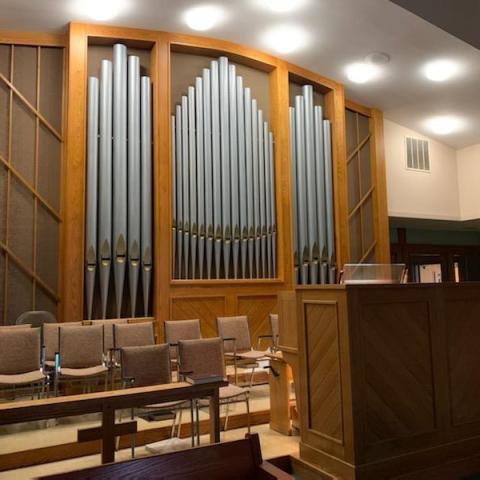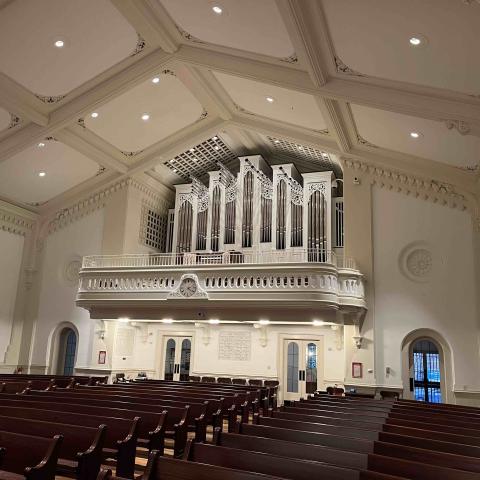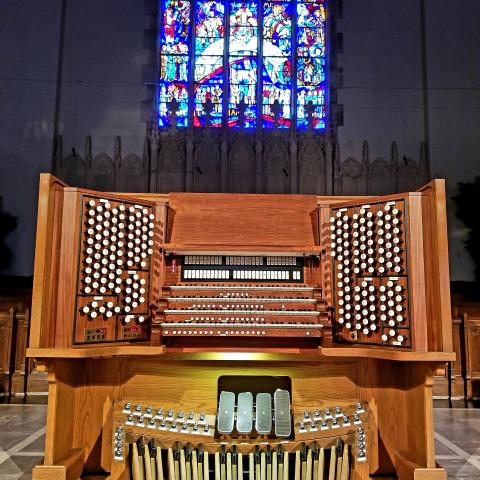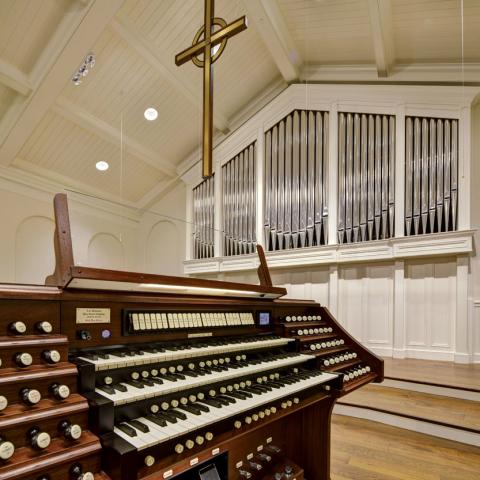B. Rule & Company, New Market, Tennessee;
First Presbyterian Church, Knoxville, Tennessee
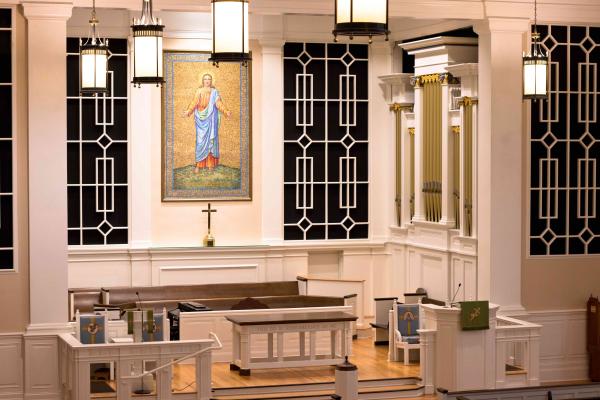
The organ at First Presbyterian Church, Knoxville, Tennessee, represented in 1963 the ideals of the modernist side of the Organ Reform movement then in vogue. Like Modernism itself, asserting a dynamic of utter clarity of structure and form, Casavant Opus 2756 spoke boldly and brightly into the nave with nothing to hinder its clear tonal egress. Those who are old enough to remember that era recall it as an exciting time: dull, inarticulate organs hidden in chambers, voiced on high pressures and devoid of any “sparkle” were being replaced with articulate, bright instruments on low pressure, speaking directly into the space.
After fifty years of heavy use, a consensus had emerged from generations of First Presbyterian’s choir directors and organists that the instrument was too inflexible, too aggressive, and often tiring to listen to. Useful accompaniment stops were few and far between, and the full plenum was uncomfortably loud. Romantic-era organ literature did not come off well. Choir members often expressed dread if the organist had planned an energetic prelude! It did not help that the instrument spoke into an acoustically dead room.
Our first step was to make an analysis in an attempt to address the many complaints about the organ, which actually contained much beautifully made pipework and a well-thought-out stoplist. Below is a summary of our findings.
Pipework
The scaling of the principals and flutes of the Pedal and Great was, surprisingly, very close to scales we ourselves would utilize for such a room, although most ranks increased in scale toward the treble more than we would have chosen. Some became so widely scaled in the treble as to be highly unusual.
Acoustics
Sound energy from the organ dropped off quickly in the room. For a room of moderate size (seating 350–400) the loss of energy was puzzling. Perhaps the aggressive voicing was an attempt to get the organ sound to travel the length of the acoustically dead nave.
Further investigation revealed, after some gentle tapping on the nave walls with our “proprietary acoustical sounding rod” (i. e., a long pine stick), that in many places the plaster was entirely loose from the solid brick walls. In addition, the ceilings of the side aisles consisted of Masonite pegboard. Pew cushions absorbed any remaining sound energy.
Esthetics
The once elegant neo-classical sanctuary had gone through a number of unfortunate contemporary alterations in 1963. The front walls of the church had been turned into one seamless Bauhaus curtain wall, with repetitive rectangles created by two-by-sixes, all covered with metal screening and painted white. A casual observer would assume it to be a huge cold-air return. The sanctuary also lost its lovely Tiffany chandeliers in the bid to bring everything up to date.
Solutions
Pipework: Further analysis of the pipework showed that, in the ranks that became unusually large in the treble, the mouths were also wider than normal. This, combined with open-toe voicing and no nicking, created an aggressive attack and an abrasive vowel sound: think of the short “a” when one sharply utters the word “scat” to an unwanted animal. The only remedy for this was to replace those pipes.
The two worst offenders in vowel sound were the 2′ Great Fifteenth and the Swell 4′ Spitz Principal. Replacing just these two ranks with properly scaled pipes aided considerably in bringing the organ into blend. The remaining ranks were effectively revoiced by closing toes, opening windways, and adding discreet nicking.
The large-scaled Pedal and Great trumpets were originally voiced with a distinctive curve so that the initial tongue slap on the shallot created an audible attack; this curve also contributed to a similar short vowel sound. Adding considerably more curve changed the character of these stops completely, resulting in a darker vowel sound with more fundamental tone.
The Swell Trumpet and Basson were replaced with new reed stops (8′ Trumpet and 16′ Clarinet) made by Fred Oyster and designed to meld tonally with this instrument. Both ranks turned out exceptionally well. New flue pipework was made by Janusz Lasota, and the gold, Roman mouth façade pipes were made by Organ Supply Industries.
Wind pressures were raised slightly to help create more fundamental tone and better control with closed-toe voicing. However, all of the flutes were left with open toes, as were most of the rather delicate Positive principal stops.
We augmented the Pedal division with a circa-1910 “mega-Bourdon” (as known in organbuilder parlance) on 4½ inches wind pressure to add significant weight under big registrations; this was a much-needed addition to the bass-deficient 1963 tonal scheme. A 16′ Principal was out of the question due to space limitations.
Acoustics: The walls in the problem areas were re-plastered and the pegboard in the aisle ceilings was removed to reveal hard plaster. This, along with removal of the pew cushions, made a distinct improvement in the room resonance, particularly in the bass.
Esthetics: we built two matching organ cases in Classical style to replace the 1963 metal grilles: in tone openings without organ cases we built new grilles after a pattern developed by Thomas Sheraton for library cabinet doors. The new grille design also nicely replicates the lead came tracework in the older stained glass windows. Former organbuilder and now architect William Dunklin designed the organ façades; it was a real pleasure to work with an architect who understood the esthetics and proportions of classical architecture as well as the musical requirements of the organ.
Console: the 1963 console with vertical jambs, while handsome, was bulky and tall. We built a new low-profile console with terraced jambs to make the work of an organist/choirmaster easier.
The new console specifications are as follows: cabinet of maple, to match existing pews and trim; terraced stop jambs and key cheeks of sapele. The oblique knobs are of pau ferro and maple, and the electric knob units as well as the knobs and labels are from Harris. The music rack is book-matched mahogany crotch burl with integral LED music light. The control system is a Peterson ICS-4000 with MIDI, 99 levels of memory, and sequencer.
Results: the sound of both organ and choir now projects nicely down the full length of the nave. The organ sings with a warm, pleasant voice, yet the clarity of the plenum is still excellent. It now handles literature from Bach to Duruflé very successfully. The instrument is ready for at least another half-century of good service to this congregation.
Many thanks to Denis Blain at Casavant for his advice on re-leathering the low-pressure Casavant pitman chests. Also to Mark Pace, organist, for hospitably making our installation as easy as possible.
B. Rule & Company staff:
Steven Lloyd
Hannah Martin
Naomi Martin
Julie Mundy-Sullivan
Brad Rule
GREAT (Manual II, wind pressure 2-11⁄16″, increased from 2″)
16′ Diapason Dolce 1–7 from Gedeckt, new, 8–26 in façade 54 pipes
16′ Gedeckt revoiced 61 pipes
8′ Principal 1-17 new, in façade, revoiced 61 pipes
8′ Diapason Dolce ext 16′ Diapason Dolce 12 pipes
8′ Bourdon revoiced 61 pipes
4′ Octave revoiced 61 pipes
4′ Spireflute new 61 pipes
2-2⁄3′ Twelfth revoiced 61 pipes
2′ Fifteenth new from middle C 61 pipes
1-1⁄3′ Mixture IV revoiced 244 pipes
8′ Trumpet revoiced 61 pipes
SWELL (Manual III, enclosed, wind pressure 3″, increased from 2-3⁄4″)
8′ Chimney Flute revoiced 61 pipes
8′ Salicional revoiced 61 pipes
8′ Celeste revoiced 61 pipes
4′ Principal new from middle C 61 pipes
4′ Nachthorn revoiced 61 pipes
2-2⁄3′ Nasard revoiced 61 pipes
2′ Blockflöte revoiced 61 pipes
1-3⁄5′ Tierce revoiced 61 pipes
1-1⁄3′ Fourniture IV originally 2⁄3′, revoiced 244 pipes
16′ Clarinet new, replaces 16′ Basson 61 pipes
8′ Trumpet new 61 pipes
8′ Oboe revoiced 61 pipes
Tremulant
POSITIVE (Manual I, wind pressure 2-1⁄4″, increased from 1-7⁄8″)
8′ Spireflute replaces 8′ Quintadena 61 pipes
8′ Gedeckt revoiced 61 pipes
4′ Principal revoiced 61 pipes
4′ Koppelflöte revoiced 61 pipes
2′ Superoctave revoiced 61 pipes
1-1⁄3′ Nasat revoiced 61 pipes
1′ Sifflöte revoiced 61 pipes
1⁄2′ Zimbel III revoiced 183 pipes
8′ Krummhorn revoiced 61 pipes
Zimbelstern
PEDAL (wind pressure 3″, increased from 2-3⁄4″)
16′ Bourdon new, large scale, wind pressure 4-5⁄8′′ 32 pipes
16′ Subbass unaltered 32 pipes
16′ Violone revoiced 32 pipes
16′ Gedeckt from Great
8′ Principal revoiced 32 pipes
8′ Gedeckt revoiced 32 pipes
4′ Choral Bass revoiced 32 pipes
4′ Rohrflöte revoiced 32 pipes
2′ Nachthorn revoiced 32 pipes
2′ Mixture IV revoiced 128 pipes
16′ Trombone revoiced 32 pipes
8′ Trumpet revoiced 32 pipes
4′ Schalmei revoiced 32 pipes
Chamade to Great (wind pressure 4-3⁄4′′) 61 pipes
Chamade to Great 16
Chamade to Positive
Chamade to Pedal
Couplers
Great to Pedal
Swell to Pedal
Positive to Pedal
Swell to Great 16
Swell to Great
Positive to Great
Pedal to Great
Swell to Positive 16
Swell to Positive
Swell to Swell 16
Great/Positive Reverse
46 stops, 55 ranks, 2,925 pipes
Peterson ICS 4000 with MIDI, Record/Playback, Sequencer, 100 levels of memory
Pistons:
10 generals
5 divisionals each division
Next and Previous
Swell, Great, and Positive to Pedal reversibles
Chamade to Great reversible
Chamade to Positive reversible
Zimbelstern reversible
Swell expression pedal 16 stages
Programmable Crescendo pedal
Builder’s website: http://bruleorgans.com
Church website: www.fpcknox.org
Photo credit: Hannah Odom


